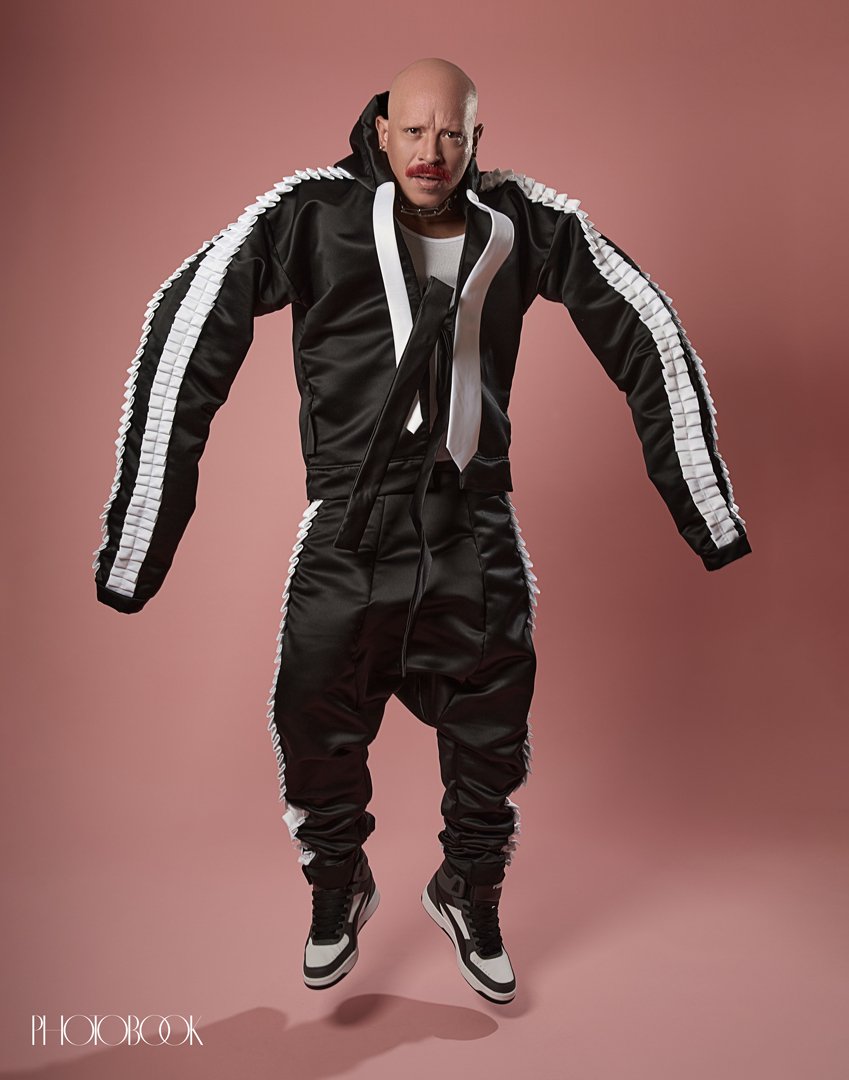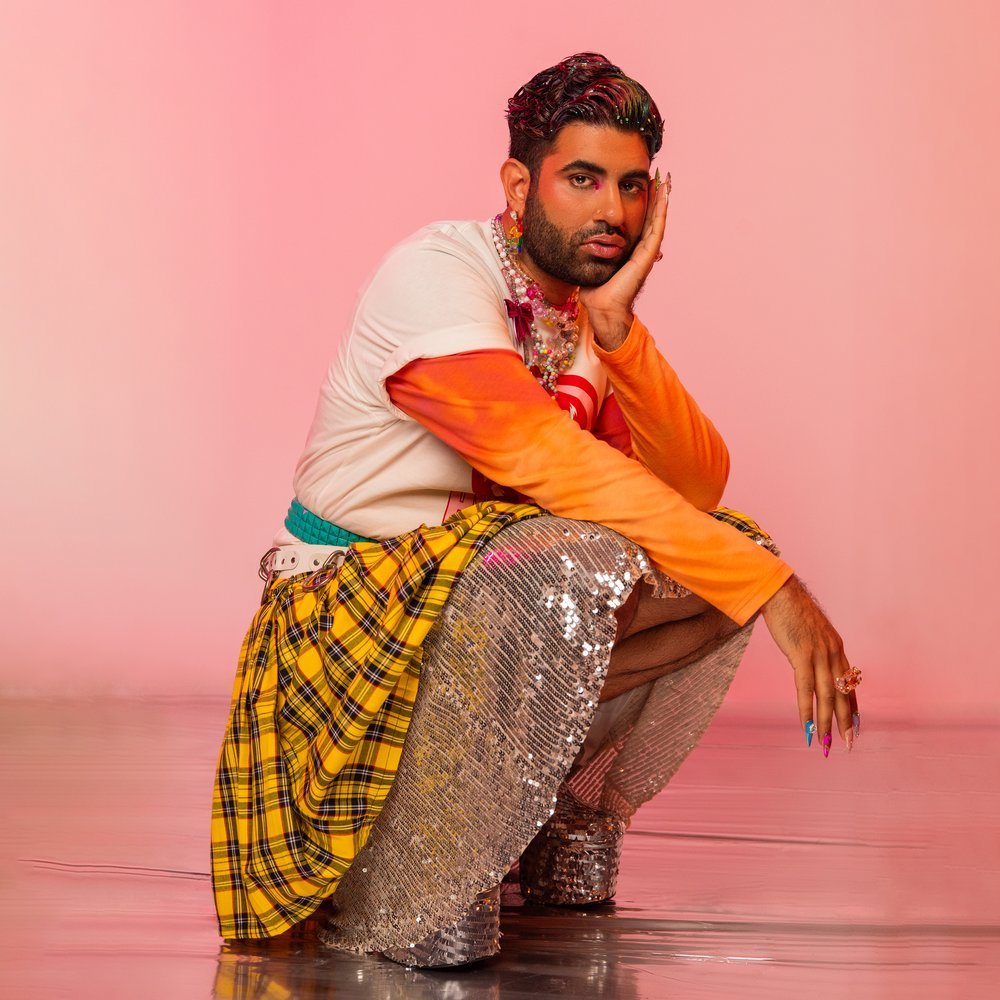Genderless Avant-garde Street-wear Line: Dope Tavio
Octavio Aguilar, a Puerto Rican American fashion designer, is the creator of the genderless avant-garde street-wear line Dope Tavio. As a self-taught designer, using a sewing machine for the first time at the age of 13, Dope has since become known as the star of Project Runway 19, worked on extensive editorials, music videos, and fashion shows with artists like Erykah Badu, Garbage, Kelela, and Rico Nasty highlighting his work. Now represented by Patricia Field, Dope Tavio is available at the ARTFASHION Gallery in New York City.
What sparked your interest as a designer? Can you reflect on a moment, a piece, or a story that made you realize you wanted to pursue this?
I think it was definitely when I first saw Jean Paul Gaultier collaborate with Madonna on her Blond Ambition Tour costumes in 1990. I was 11 years old at the time and what I loved most is that it was so different to what we were used to seeing people in or any artist wear at the time. I loved its boldness and the confidence that it gave her on stage and to the audience watching. I later then started following his career via fashion magazines as we didn’t have the internet but I was drawn to his designs. I then knew that I wanted to be a creative and this was the type of work and field I wanted to be in.
Tell us about your muse, rapper Sharaya J, and how your relationship has affected your journey in design.
Sharaya and I were introduced through fashion. A designer who had rented a space next to my then boutique Dita’s in New Jersey insisted that she and I meet. About five minutes after the meeting, I invited her next door. She walked in and loved what I was doing, I immediately saw her eye for fashion. About a week later we collaborated in our first shoot, then she walked in a show in my garments and won in several categories. It was a match made in heaven. Although the fashion that we both wear and design now has changed it was always dope collaborating with her. We trust each other and push each other to greater heights. Her music inspires me. I can design a whole collection with her in mind.
As a Puerto Rican American raised in New York, how did your upbringing and the culture you were exposed to affect your style and perception of fashion?
Being raised in the 80s and 90s up north had much to do with the different styles I have dabbled in. It was such a melting pot of styles. I would people watch in the streets of New York and New Jersey. It would see punk rockers, club kids, Urban Latin streetwear and basic clothing. Back then I would go to The Tunnel and Limelight to hang with all the club kids and ravers, but I would also go to alternative and goth clubs. I think being introduced to all these genres made me mix and match styles in a own personal way. The east and west village is where I got the most inspiration and would do all of my shopping, I’d spend hours going in and of shops on 8th Street in New York.
How did Dope Tavio, your label, come to fruition?
I remember attending a Patricia Field Art Basel fashion show in Miami and I was super inspired by what I saw. After returning to New York, she announced that she would be closing her boutique that had been around for 50 years. Although she kept her website running, the amount of merchandise had shrunk to just a few artist and designers. My friends and I had been shopping at her place for years, and just felt like there was a void. Around the time I was already designing pieces for Sharaya videos and performances and felt like I could experiment with starting a brand. It went from posting pieces on mannequins on my IG page to people reaching out to buy, pull and shoot. Once I got the call from Eryka Badu wadrobe team to create a look for for the Soul Train awards I knew I was on to something. From there on the phone didnt stop ringing and Dope Tavio was born. Two years after starting Dope Tavio I moved back to NY, thats when I got the call from Pat Fieild’s people, they came in to my studio and left with about 30 pieces to show to Pat. The next thing I knew Dope Tavio was being sold at Patriciafield.com. It was a dream come true!
Who are some designers or style icons who inspire you?
Jean Paul Gaultier, Alexander McQueen, and John Galliano are my three all-time favorites. They are visionaries and they tell stories through their designs and the shows they put on in the 90s. They all dressed style icons like Madonna, Bjork, Shirley Manson just to name a few. It was all editorial and that attracted me more to them.
During your time spent working in interior design before committing to your own brand, what pushed you to pursue the fashion world entirely?
I loved working in interior design but knew it wasn’t my passion. It felt like my head was hitting the ceiling and I wouldn’t be able to grow. I work for a great Brazilian company called ARTEFACTO in Miami that catered to high profile clients in which we were decorating huge mansions with oversized interiors. This would later inspire some of the pieces I would create for Dope Tavio like the oversized puffers and all the shapes and silhouettes that I do.
What inspires Dope Tavio's aesthetic?
Pop culture from both the 80s and 90s. Designers and artists were all thinking about what the future would look like and, although at the time, it felt experimental. I can see how they have influenced the way we dress and the shows we now put on. Music plays a big part when I’m in my studio creating, as I’m sketching or creating with my body form there is music playing. Music takes me to different places. it inspires me to feel things and those things help with my creative process.
How do you incorporate a sustainable aspect into your work?
Half of my collection are pieces that are upcycled. I use used blazers, dress pants and dress shirts in most of my designs but still like working with fabric off a roll. I only make one of each, instead of making a whole size run of everything. I also share fabrics with other designers and try to keep all my scraps for future ideas.
What is it like seeing your work worn by the artists with whom you’ve worked?
It’s an amazing feeling seeing artists of all sorts wear my pieces. From recording artist, visual artist, DJs, and drag queens just to name a few. Theres this connection that happens, they are working on their own projects like new albums, new videos, new performances and or new alter egos. And somehow my garments clique with what they are doing. It’s a really special feeling seeing it all come together.
What is your advice for aspiring designers?
Stay true to yourself, create your own esthetic, know who you want to dress. Create a name for yourself. Once you do that people will follow and know what’s yours without even looking to the label.
Having worked on countless editorials, presented collections for runways, and exhibited your pieces in galleries, what has been your favorite medium to display and express your art?
I would have to say my favorite is in fashion editorials. Since being a kid, I’ve loved fashion magazines. Pictures tell stories. When I’m designing I’ve got my own story in head, but then comes a stylist and pulls for an editorial with a different mood board. These images come back and bring my pieces to life with another direction in mind. It’s always a surprise to me and I’m excited to see how they styled and shot it. The whole team comes together (photographer, stylist, makeup artist, hair, and model). It’s a big collaborative effort that brings all these creative together in one photo.
Tell us about your experience at Project Runway. What was it like, and what have you taken from it in the long-term?
Project Runway was a lot of fun. it was filmed right after us experiencing the pandemic so it was good to go and make new friends and be surrounded by so much creativity. I remember the other designers and I remember it as feeling like fashion camp. I was so calm being in that bubble away from social media, TV, radio and not having a phone, I was the most focused I’ve ever been in my life. I walked away from that show with so much more confidence and was pleased with how it all played out. The doors continue to open for me because of that show. It was a once in a lifetime experience.
What have you learned from the business side of fashion, designing your brand while simultaneously promoting it?
This is a good one because I’m still learning. I think the big standout for me is that many people are into what I do with Dope Tavio, visually but not everyone can wear it. So being able to stay creative in a more ready to wear point of view has been the most exciting and challenging part. I’ve learned that fashion is a money-making business and to survive in fashion you must put out pieces that more people can wear.
Having lived in both Miami and New York. How has your work and taste evolved as you’ve Switched cities?
I love living in Miami but my heart is in New York. I still design in New York, Los Angeles, Berlin, London and Tokyo in mind. My collection is mainly black and white with sometimes a hint of color (mostly red like my mustache). Miami is full of color, people here don’t wear a lot of black or layers, you don’t see the four seasons here as you do in other cities. But I would like to change that, I wanna see more people wearing black and having a little bit more fun in their choices. Miami needs to get more creative in its looks.
How do you want to evolve as a designer and a person during the next few years?
I’m working on a few projects now that could be huge from it being a one-of-a-kind piece collection to a bigger collection with more clothing and accessories. I’d also love to do some home decor pieces and possibly one day have my own fragrance.
What dream projects do you hope to and plan to work on?
“I WANNA DRESS BJORK,” that’s my ultimate dream project.
Social Media.
Instagram: @dope_tavio
CREW CREDITS:
PhotoBook Editor-In-Chief: Alison Hernon
PhotoBook Creative Director + Photographer + Producer: Mike Ruiz + @mikeruiz.one
Talent: Dope Tavio
All Wardrobe by: Dope Tavio
MUA/Groomer: Shaleira Smith, www.shaleirasmithmakeup.com for FGB team
Tearsheets by Daniel López, Art Director, PhotoBook Magazine
Interview by Renata Salazar, Contributor, PhotoBook Magazine








